- Embrace the Freedom of the Open Road in GTA Online This Independence Day Weekend Rockstar Games
- GTA Online: Independence Day 2025 Free Rewards and Bonuses Game Rant
- GTA Online: Independence Day Weekly Update Brings 4x Money and RP on Land Races, Along With Vehicle Discounts, and More IGN India
- GTA Online Content Event Week July 3rd-9th RockstarINTEL
- How to complete GTA Online Safeguard deliveries GamesRadar+
Category: 4. Technology
-

Embrace the Freedom of the Open Road in GTA Online This Independence Day Weekend – Rockstar Games
-
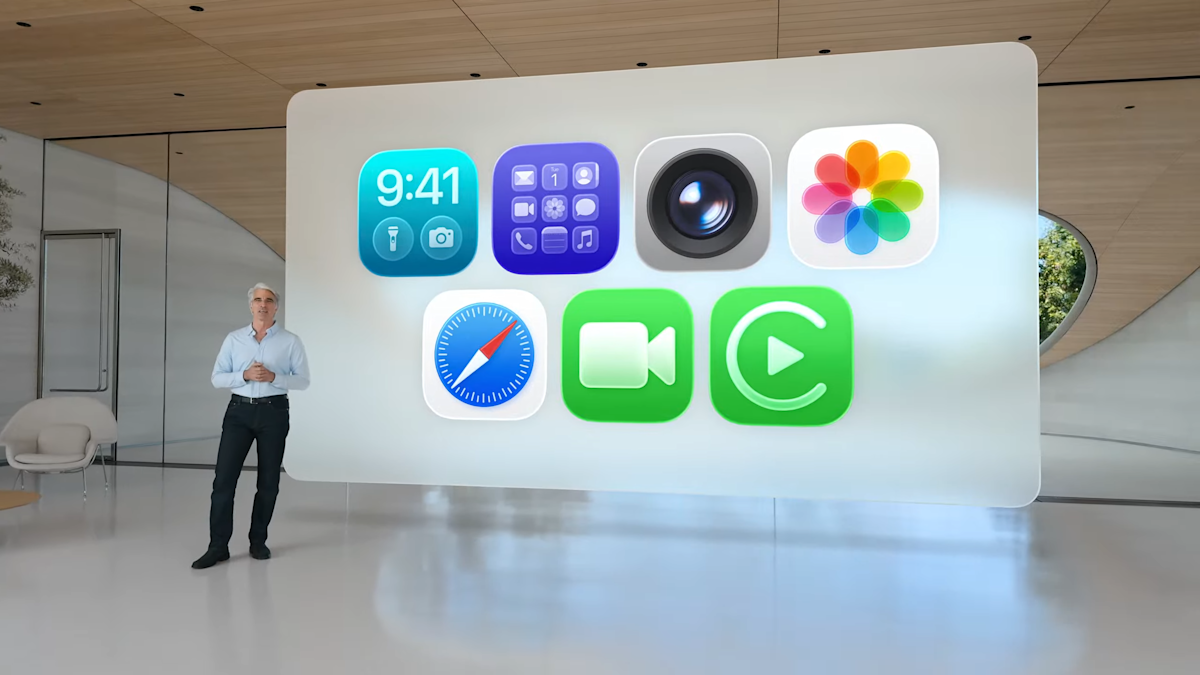
iOS 26 can freeze your FaceTime video if it detects nudity
The developer beta for iOS 26 has been out for a few weeks, and as always,tech sleuths are uncovering that weren’t explained during . Among the latest discoveries stirring up conversation online is a safety and privacy feature for FaceTime that blurs your feed when it detects you in a state of undress. Should FaceTime detect nudity, it will display a message reading “Audio and video are paused because you may be showing something sensitive. If you feel uncomfortable, you should end the call.”
Originally discovered by , the feature is off by default and can be enabled in FaceTime settings under “Sensitive Content Warning.” The feature reads, “Detect nude photos and videos before they are viewed on your device, and receive guidance to help make a safe choice. Apple does not have access to the photos or videos.”It seems the feature is intended for child accounts, though it can currently be enabled in the beta for adults as well.
The Apple support page for the company’s “Communication Safety” features reads, “Communication Safety uses on-device machine learning to analyze photo and video attachments and determine if a photo or video appears to contain nudity. Because the photos and videos are analyzed on your child’s device, Apple doesn’t receive an indication that nudity was detected and doesn’t get access to the photos or videos as a result.”
Features in beta come and go, as testing and feedback are partly the point of the beta system, so this may or may not see broader adoption. The is slated for July.
Continue Reading
-

Everything you need to know about Flashes, the Bluesky-based Instagram alternative
Flashes this year launched an Instagram alternative built on top of the Bluesky social network. Now available on the App Store, the app offers a different way to browse the visual posts on Bluesky. Instead of viewing them in a timeline-like feed, similar to X, the app draws inspiration from photo-based social networks, like Instagram.
What you can post
The app, built by Berlin-based developer Sebastian Vogelsang, runs on the same underlying protocol that powers Bluesky, the AT Protocol (or atproto for short). That means it will have the same requirements around posting images and videos as you’d find on Bluesky directly.
Originally, that meant support for posting up to four images and videos of one minute in length, but as of the Bluesky version 1.99 update released on March 10, users have been able to upload videos up to 3 minutes in length.
Image Credits:Flashes How Flashes is like Instagram — and how it’s different
Flashes is somewhat similar to Instagram, as it offers a scrollable feed of photos and videos, user profiles, and even photo filters to enhance your images when posting.
Instead of having to start your network from scratch, Flashes’ users are immediately tapped into the wider Bluesky community, which now has over 37 million users. Even if not all of Bluesky’s users are on Flashes, their images and videos will be displayed in the app, as it essentially filters the Bluesky feed for visual content.
When you post on Flashes, it creates a post that appears on Bluesky as well. (For that reason, you may want to make a secondary Bluesky account if you want to keep the two networks separate.)

Image Credits:Flashes In addition, the app lets you browse your own Bluesky feeds and choose from Bluesky’s over 50,000 custom feeds, including those that focus on particular topics — like art, birds, gardening, or cat pics, for example — or those dedicated to specific formats, like Bluesky’s video feed.
As you browse through the posts in Flashes, you can like, repost, and reply to them, just as you could on Bluesky itself. Those interactions will also appear in Bluesky’s app, while Bluesky users’ interactions will show up in Flashes.
Photographers looking for a place to showcase their work will appreciate Flashes’ “Portfolio” feature.
To toggle this setting on, you’ll head to the “Advanced” tab on your user profile, then tap on “Flashes profile.” Here, there will be an option to enable Portfolio, which lets you curate which images should appear on your Flashes user profile.
You can also customize your user profile further by opting to show or hide likes, lists, and feeds, or using other media filtering options.
How to get started
To use Flashes, you’ll first need a Bluesky account. If you already have one, you can sign in with those credentials.
If not, you can choose to sign up for a Bluesky account from within the Flashes app. The app defaults to setting up your account on the main Bluesky server, bluesky.social, but more technical users can opt to set up a custom hosting provider instead.
To create your account, you’ll need to provide an email address, password, and date of birth, then accept the terms of use, which means you agree to Bluesky’s Community Guidelines and Terms.
Once signed in, you can immediately start browsing the images and videos shared on your Bluesky timeline or any other Bluesky feed, or post your own media.
A subscription may be coming
Vogelsang hopes that Flashes will help pull in more users to the Bluesky community, including those who aren’t as interested in a Twitter/X-like experience. Instead, the app appeals more to people looking for open alternatives to Meta’s Instagram.
It’s not the only app building in this space, however. Another app working on similar experiences is Pinksky. Meanwhile, users of Mastodon’s social network may prefer Pixelfed, which uses the fediverse’s ActivityPub protocol under the hood instead of Bluesky’s atproto.

Image Credits:Flashes Over time, Vogelsang wants to add more features to Flashes, like push notifications, support for multiple accounts, bookmarks, and more editing options.
Plans to add subscriptions with premium features are in the works, which would help fund Android and web development. These paid tiers could also provide premium access to Vogelsang’s third-party Bluesky app, Skeets, and his video-focused app, Bluescreen.
Other planned features include iPad layout improvements, support for longer videos, posts that are only visible for a limited time (like Stories), albums, and batched image transfer from other platforms. Eventually, the developer would like to evolve Flashes to be its own AT Protocol-based platform, while still being compatible with Bluesky’s network.
The app is a free download from the App Store and requires iOS 17 or higher to run.
Continue Reading
-
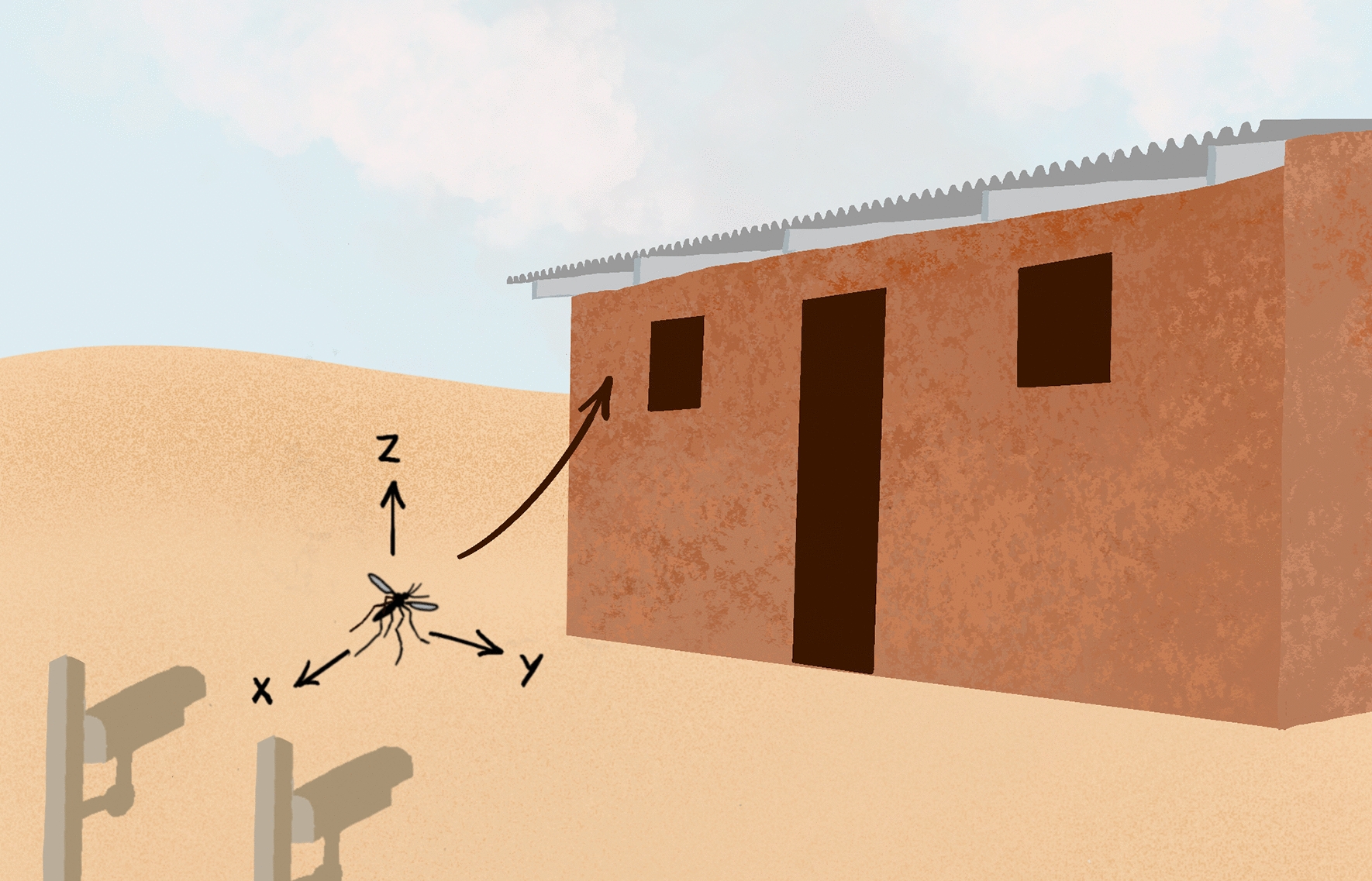
The effect of eave and window modifications on house entry behavior of Anopheles gambiae | Parasites & Vectors
Mosquito colony
All mosquitoes used in this study were colony-reared An. gambiae (Kisumu strain). Eggs to establish the colony were initially obtained from the Malaria Alert Centre, Blantyre, Malawi, and the colony was maintained in the laboratory facilities at Majete Wildlife Park in Chikwawa District, Malawi. The colony rearing facility was not climate controlled, and the temperature and relative humidity in this facility ranged from 24 °C to 36 °C and from 62% to 85%, respectively. Mosquitoes were allowed to blood-feed twice per week on a human arm, and eggs were distributed over larval rearing trays (46 × 30 × 9 cm) filled with water from a well near the laboratory facility or from a tap at the nearby Kapichira Power Station. Each tray held 300–400 larvae, fed on ground pellets of Marltons koi and pond fish food (Marltons Pet Care Pty Ltd, Westmead, South Africa). Pupae were collected daily and placed in cages for emergence to adults. All cages with adult mosquitoes were provided a 10% sucrose solution via a piece of soaked cotton wool. Cages with experimental mosquitoes were not provided with a blood meal prior to the experiments.
Experimental set-up
Experiments were performed in a semi-field screened enclosure measuring 12.0 × 12.0 × 2.1–4.0 m (length, width, height) at the Majete Wildlife Park in Chikwawa District, Malawi. The walls of the screened enclosure were made from fiber glass, mosquito-proof screening (Phifer Inc, Tuscaloosa, AL, USA), and the roof was a waterproof tarpaulin. Within this enclosure, we built an experimental house measuring 5.0 × 3.0 × 2.2–2.7 m (length × width × height) (Fig. 1). The walls of the experimental house were constructed from locally produced bricks and plastered with cement, and the roof was made of corrugated iron sheets, including a 20-cm overhang. The front wall of the experimental house was fitted with a door (inner dimensions 197 × 60 cm) in the middle, two windows (30 × 30 cm) and four removable eave frames (inner dimensions 90 × 10 cm per frame). The back wall of the house was also fitted with two windows and four eave frames, but no door. The wooden door, window frames and eave frames were painted black with water-based chalkboard paint.
Fig. 1 The experimental set-up for studying house-entry behavior of female malaria mosquitoes. a Schematic top view of the screened enclosure (12 × 12 m) including the experimental house (brown rectangle 3 × 5 m), the 4 high-speed cameras (labeled C1a, C2a, C1b, C2b), the infra-red lights for camera illumination (IR) and the mosquito release point (R). b Picture of the experimental setup, showing the large screened enclosure and within it the experimental house with door, window and metal roof with eave, and the 4 high-speed cameras and infra-red lights. c Example showing an overlay of all mosquito flight tracks within 1 experimental night with eaves and windows screened. A blue line was drawn each time a single mosquito entered the view. Orange to red colors are used to indicate when more individuals were tracked at the same time. d The three-dimensional (3D) coordinate system and volume in front of the house in which the mosquitoes could be tracked using our videography system. The X-axis and Y-axis are oriented normal and parallel to the front wall of the house, and the Z-axis is oriented vertically. The 3D trackable volume is highlighted in white and projected on the floor, house and the house symmetry plane. The location of the eave and window are indicated in red, with an eave height of between 2.12 and 2.31 m and a window height of between 1.48 and 1.97 m. e, f To study the flight activity near the eave and window, we defined corresponding volumes-of-interest near these structures, as defined by the blue boxes.
The windows and eave frames could be left completely open, fitted with insect screens or closed completely with wooden shutters. The screens were made of charcoal-colored fiber glass (Wire Weaving Co. Dinxperlo, The Netherlands), and the shutters were made of plywood painted black with water-based chalkboard paint. Using this system, we were able to systematically investigate the effect of window and eave closure and screening on mosquito house-entry behavior. The door remained closed overnight for all experimental treatments.
Two beds were positioned inside the house, one along each outside wall, and each bed was covered with an untreated bednet. During experimental nights, one adult man slept in each bed, under the bednets, to act as a bait for mosquitoes. Three pairs of adult men volunteered to sleep in the house for 10 experimental nights each. Written informed consent was obtained from the volunteer sleepers. The College of Medicine Research and Ethics Committee (COMREC) in Malawi approved the study (Proposal Number P.02/19/2598). A US Centers for Disease Prevention and Control (CDC) light trap (John W. Hock Ltd, Gainesville FL, USA) was placed near each bed to collect a sample of the mosquitoes that entered the house [28, 29].
Camera and real-time mosquito tracking set-up
A multi-camera videography system was used to track the three-dimensional (3D) flight kinematics of An. gambiae mosquitoes around the experimental house. The videography system consisted of four synchronized machine-vision cameras (Basler acA2040-90umNIR, USB 3.0; Basler AG, Ahrensburg, Germany), equipped with 16-mm f1.4 wide-angle lenses (Kowa LM16HC; Kowa Optical Products Co., Ltd., Nagoya, Japan), with lens aperture set at f2.8. The cameras were operating at 50 frames per second (fps), with a 1-ms exposure time. To improve the light sensitivity of the cameras, pixels within each 2 × 2-megapixel camera image were binned 2 × 2. Binning combines the charge from adjacent pixels (in this case, 2 × 2-pixel bins), resulting in increased light sensitivity but a reduced spatial resolution (in this case, reduced to 1 × 1 megapixel). Image capture on the cameras was synchronized by means of an external trigger pulse, generated by an Arduino Uno microcontroller board (Arduino, Monza, Lombardy, Italy) (https://github.com/strawlab/triggerbox.git).
To protect the cameras and lenses from water, heat and dust, each set was placed in a camera housing (Transpac THP 4000; Basler AG, Ahrensburg, Germany). These camera housings were mounted onto an aluminum frame (MayTec Aluminium Systemtechnik GmbH, Olching, Germany) that was fixed to the concrete floor on which the house was built (Fig. 1b). The cameras were placed at an approximate distance of 2.5 m from the front wall of the house, at heights between 0.8 and 1.3 m. As a result, the camera system imaged the front, right side of the experimental house, including half the door and one window. The cameras were oriented slightly upwards to film the volume below the roof near the eave area. The dimensions of the area in front of the house where mosquitoes could be tracked were approximately 2.5 × 1.0 × 1.5 m (Fig. 1d).
The filming volume was illuminated with eight near-infrared light-emitting-diode (NIR-LED) lights (two ABUS TVAC71000-60° lights and six ABUS TVAC71070-95° lights; ABUS, Volmarstein, Germany). The NIR-LED lights were mounted on a frame placed on the concrete slab directly below the area of interest (Fig. 1b), and the lights were directed upwards and arranged to uniformly light the filming volume near the eave and window, aiming for optimal contrast between the illuminated mosquitoes and the dark background of the house.
We used an automated tracking software [30] to track in real-time the positions of multiple mosquitoes flying in the four camera views, and from these we reconstructed the 3D flight tracks. The tracking software ran on a single laptop (Lenovo ThinkPad P51; Lenovo, Beijing, China) with an Intel Xeon E3-v6 processor and Ubuntu Linux operating system, which performed the real-time image analysis and object tracking for all four cameras, as well as the 3D flight track reconstruction. Based on pilot recordings, sensor gain was set to 1.0 for all cameras, and the maximum number of simultaneously tracked mosquitoes was set to 10. Tracks were reconstructed only when the mosquito was visible in at least two of the four camera views. A dynamic background model was used with update intervals for each 100 frames and a 1% weight factor to compensate for slow changes in illumination conditions.
Cameras were calibrated with the multi camera self-calibration routine [31] by tracking a single moving LED light with each of the four cameras (Cree SunBright 535 nm Green LED; CreeLED Inc, Durham, NC, USA). This calibration was aligned to world reference points based on landmarks on the experimental house. The resulting coordinate system in the world reference frame was defined as X, Y, Z, with the X-axis oriented perpendicular to the house front wall, the Y-axis oriented parallel to the house front wall along the ground and the Z-axis oriented vertically. We defined values within this coordinate system as {x, y, z}, with the origin {x, y, z} = {0,0,0} located against the house front wall (x = 0), on the ground in front of the house (z = 0) and (y = 0) at the right side of the door frame as observed from the cameras.
The calibration procedure was repeated every experimental day to correct any inadvertent change in camera position. A correction for lens distortions was generated for each camera at the start of the experiment, using a 6 × 10 checkerboard pattern with 90-mm squares. Distortion parameters were computed using openCV procedures (https://docs.opencv.org). Tracking results were corrected for lens distortions.
Videography experiments were performed from 20:00 to 04:00 h. If volunteers briefly left the experimental house during the night, a 5-min buffer period was marked prior to leaving and post re-entering the experimental house. Tracking data within those time slots were removed from further analyses.
Eave and window modifications
We evaluated five experimental house modifications (Fig. 2). For our control condition, both the eaves and windows were fully open (eaves open – windows open [EO-WO]). We used two treatments to test the effect of window modifications on mosquito house entry behavior. In the first treatment, we screened the windows and left the eaves open (EO-WS), and in the second treatment we closed the windows while leaving the eaves open (EO-WC). To test the effect of eave modifications on mosquito house entry behavior, we used treatments in which we screened or closed the eaves while, in each case, screening the windows (ES-WS and EC-WS, respectively).
Fig. 2 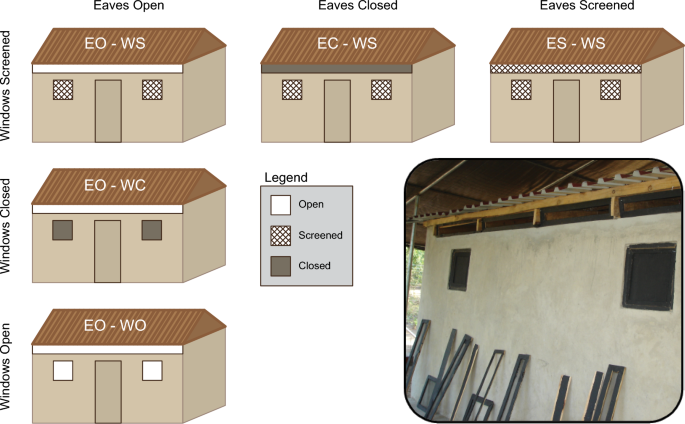
Overview of the five different experimental treatments, in which we systematically closed or screened the window and eave. In the overview, the three rows show the different window treatment conditions (from bottom to top: open, closed and screened), and the three columns show the eave treatments (from left to right: open, closed and screened). Each condition was defined using a four-letter code, where E, W, O, C, and S stand for Eave, Window, Open, Closed and Screened, respectively. The door was closed during all experiments. Eave and window treatments were changed using removable frames, as shown in the inset image. The inset image shows the back of the experimental house, where the eave and window treatments were the same as the front.
Experimental procedure
Before each experiment, the house was prepared by closing, screening or leaving open the eaves and windows, as randomly assigned for each replicate night of the study (Fig. 2). Each treatment was in place for 6 replicate nights (see experimental treatment schedule in Additional file 1: Table S1).
On the day of each experimental replicate, 500 female mosquitoes (5–8 days old and not previously blood-fed), were selected before 12:00 h and set aside in the insectary in a release bucket (diameter 12.5 cm, height 12.5 cm), covered with a mesh and provided with water-soaked cotton wool. Two volunteers slept inside the house under untreated bednets, starting at 19:30 h. The volunteers’ heads were positioned towards the front (door) side of the house, and each pair of volunteers shifted beds (to the left or right side of the house) after each replicate. At 19:30 h, the two CDC light traps at the end of each bed were turned on, with their lights switched off, and the bucket with mosquitoes was placed in the screened enclosure, 5.8 m in front of the experimental house.
At 20:00 h, mosquitoes were released from the bucket by lifting the mesh using a fishing line operated from outside the screened enclosure. Mosquito flight was tracked until 04:00 h, after which the CDC light traps were turned off, and the volunteers could leave the house. Any temporary absence of volunteers during the recording period was recorded in a logbook. A Prokopack aspirator (John W. Hock Company) was used to collect mosquitoes from inside the experimental house at 04:00 h. Together with these Prokopack catches, CDC light trap catches were briefly frozen, and the collected mosquitoes were then counted. Mosquitoes remaining in the release bucket were also counted, and the number of responding mosquitoes for each replicate night was defined by subtracting the number remaining in the release bucket from the initial 500 mosquitoes. Remaining mosquitoes found inside the screened enclosure later that day were removed with the Prokopack and discarded after freezing. Experimental replicates were carried out no more frequently than every other day to ensure proper preparation and to allow any uncaught mosquitoes remaining in the screened enclosure to die before the next experimental replicate.
Data analysis
The real-time tracking algorithm used a Kalman predictor to reconstruct 3D flight paths from stereoscopic videography data [30], and thus the output data consisted of Kalman-filtered flight paths defined by location, flight velocity and the Kalman covariance error e(t). In post-processing, we filtered the resulting database of flight tracks in two steps. First, to remove potential extrapolation errors from the Kalman predictor, we deleted the end of tracks if either the estimated flight speed exceeded 1.5 m/s or the Kalman covariance error was > 0.01. Second, we then discarded all tracks that were shorter than 10 cm or less than 0.2 s (10 video frames at 50 fps). These settings were based on a sensitivity analysis and the assumption that flying Anopheles mosquitoes have a maximum flight speed of < 1.5 m/s. The resulting flight paths consisted of the temporal dynamics of the 3D location {x(t), y(t), z(t)} and velocity {u(t), v(t), w(t)} of each flying mosquito; these were used for our subsequent analyses.
We used all combined flight tracks per treatment to calculate average mosquito density distributions and flight velocity distributions around the house. For this, we divided the filming volume into 40 × 40 × 40 voxels (spatial bins), resulting in an approximate voxel size of 5 cm in the X- and Z-direction, and 7.5 cm in the Y-direction. In each voxel we estimated the mosquito density as the relative proportion of time mosquitoes spent in that voxel, defined as T* = Ti/Ttotal, where Ti is the time spent in voxel i, and Ttotal is the total flight time. We visualized these density distributions as heat maps projected on three two-dimensional (2D) planes (X–Y, X–Z and Y–Z). We determined the flight velocity vector in each voxel as the mean flight velocity of all mosquitoes that passed through that voxel. We visualized the velocity distributions using streamline plots derived from these velocity fields, projected on the same set of 2D planes as for the density distributions (X–Y, X–Z and Y–Z).
For measuring and comparing flight activities near the eave and window area, we defined volumes-of-interest around the eave and window (Fig. 1e, f, respectively). These volumes had the same rectangular or square shape as the eave or window, respectively, but extended 10 cm on each side (in the Y- and Z-direction). The volumes started at the wall and extended 30 cm outward in the direction perpendicular to the wall (in the X-direction). We then identified all flight tracks that intersected these volumes around the eave and window. Based on these, we quantified flight activity around the window and eave using the time that mosquitoes spent in the corresponding volumes. We determined this time spent in each volume by summing all durations that flight tracks remained in the defined volume; this was done for each experimental night and for an array of time bins with a temporal resolution of 10 min.
Next, we used the flight tracks around the window and eave to study when and how mosquitoes visited the window and eave, and when and how they arrived, departed, remained in and returned to these volumes. ‘Arrivals’ were defined as flight tracks that started at least 10 cm outside the volume-of-interest and ended within the volume. ‘Departures’ started within the volume-of-interest and ended at least 10 cm outside the volume. ‘Visitors’ started outside the volume-of-interest, entered the volume, left the volume and finally ended outside the volume. ‘Returnees’ started inside the volume-of-interest, left the volume, re-entered the volume and finally ended inside the volume. ‘Remainers’ started and ended inside the volume-of-interest, without moving outside the volume. It should be noted that if a flight track ended within the window or eave volume, the mosquito might have entered the house or might have landed on the house, because the tracking algorithm only tracked mosquitoes flying outside the house.
Based on these data, we determined the number of mosquitoes that showed each type of flight behavior (visiting, arriving, departing, remaining and returning). We then used the flight kinematics data to determine the behavior-specific flight dynamics around the eave and window. Specifically, we constructed streamline plots, both per treatment and across all 30 replicates, for all mosquitoes that arrived at the volumes around the eave and window. To focus on the approach kinematics only, we removed the parts of the tracks after arrival.
We used analysis of variance (ANOVA) to test for differences among treatments in various flight kinematics and house entry parameters. The dependent parameters were the number of responding mosquitoes, the percentage of responding mosquitoes collected inside the experimental house, flight track duration (time spent) and the number of flight tracks. We used Tukey’s HSD for pairwise comparisons when the ANOVA test showed a significant difference between treatments. We also used ANOVA to test for differences in house entry rates among the three pairs of volunteer sleepers. We defined P < 0.05 as significant, 0.05 ≤ P < 0.10 as marginal, and P ≥ 0.10 as non-significant.
Continue Reading
-
![[UPDATE] Romero Games Employee Says ‘Whole Studio’ Subject to Layoffs After Microsoft Pulls Funding for New Shooter from Doom Co-Creator John Romero](https://afnnews.qaasid.com/wp-content/uploads/2025/07/1751614671_gettyimages-2148301815-1751541798386.jpg)
[UPDATE] Romero Games Employee Says ‘Whole Studio’ Subject to Layoffs After Microsoft Pulls Funding for New Shooter from Doom Co-Creator John Romero
UPDATE: A Romero Games employee has claimed that Microsoft’s decision to pull funding from the studio’s in-development project has led to the entirety of the studio being laid off.
“Today I found out our whole studio is being let go because of the layoffs at Microsoft,” the staff member wrote via a post on LinkedIn.
“A very sad day,” wrote another employee impacted by layoffs. “It breaks my heart to say that Romero Games fell victim to the 9,100 Microsoft layoffs today. The best team I’ve ever worked with and my dream job gone just like that. It really was a great project and it’s hard to process that it’s over. It’s nothing less than tragic.”
More than a dozen Romero Games employees have now publicly stated they have been impacted by the layoffs and are now looking for work, according to LinkedIn profiles reviewed by IGN. Romero Games formally announced its funding had been pulled just hours ago, as detailed below.
ORIGINAL STORY: Romero Games, the studio founded by Doom co-creator John Romero and Brenda Romero, has said it has been left “heartbroken” after discovering that funding for its next project has been pulled, reportedly as part of Microsoft’s latest cuts, leaving the game and its team at risk.
In a statement, studio director Brenda Romero said the company’s publisher and financial partner confirmed last night it was walking away from the project “along with several other unannounced projects at other studios.”
Brenda and John Romero. Image credit: Shane Anthony Sinclair/BAFTA/Getty Images for BAFTA. A separate post on social media, a now-former Romero Games employee stated that they are now out of work at the developer “due to the recent Xbox layoffs.” IGN has contacted Microsoft for comment.
The news comes just hours after Microsoft’s latest round of mass layoffs impacted numerous internal Xbox studios, resulting in the cancellation of multiple projects including Everwild and Perfect Dark, as well as other, unannounced titles that Microsoft had been funding.
“This was a strategic decision made at a high level within the publisher, well above our visibility or control,” Romero stated. “We deeply wish there had been something, anything, we could have done to prevent this outcome.”
Romero suggested that the publisher’s decision had come as a surprise, as Romero Games had “hit every milestone on time, every time, consistently received high priase, and easily passed all our internal gates”.
For now, Romero Games said it was “currently evaluating next steps and working quickly to support our team”, and asked for anyone with “any opportunities or ways you can help our incredible team” to “please reach out.”
“These people are the best people I’ve ever worked with,” John Romero himself said, sharing the news via social media. “I’m sorry to say that our game and our studio were also affected.”
Romero Games’ recent projects include 2019’s Sigil and its 2023 sequel Sigil 2, as well as mafia strategy game Empire of Sin, launched in 2020.
Little is known of what Romero Games had been working on for the past few years, other than it was a new first-person shooter made with Unreal Engine 5. Back in July 2022, the company said it was expanding to work on the project after securing funding.
“It’s a new dawn for Romero Games,” the studio said at the time. “We’re working with a major publisher to develop John Romero’s next shooter: an all-new FPS with an original, new IP.”
Image credit: Shane Anthony Sinclair/BAFTA/Getty Images for BAFTA.
Tom Phillips is IGN’s News Editor. You can reach Tom at tom_phillips@ign.com or find him on Bluesky @tomphillipseg.bsky.social
Continue Reading
-

PlayStation’s ‘Helldivers 2’ Coming to Xbox in August
The crossplatform walls are slowly but surely coming down more and more, as Sony Interactive Entertainment’s “Helldivers 2” makes its way to Microsoft’s Xbox gaming console this August.
Formerly a PlayStation and PC exclusive title, the third-person co-op shooter developed by Arrowhead Game Studios and published by PlayStation will launch for Xbox Series X and S on Aug. 26.
“Helldivers 2” is a described as a “cooperative, third-person feast of destruction where players and up to three squadmates step into the boots of an elite class of soldiers whose mission is to spread peace, liberty, and Managed Democracy using the biggest, baddest, and most explosive tools in the galaxy.”
The game launched for PlayStation and PC in February 2024 and was a critical and commercial hit.
“We know gamers have been asking for this for some time and we are so excited to bring more Helldivers into our game,” “Helldivers 2” game director Mikeal Eriksson said in a statement Thursday. “We have so much more in store for the future months and years – and the more players we have the more stories we can tell! The fight for Super Earth has only just begun.”
“Helldivers 2” is coming to Xbox on the heels of Xbox’s releasing one of its current hottest titles on PlayStation: “Indiana Jones and the Great Circle.” Microsoft really kicked off industry-wide conversations surrounding breaking down the barriers for console-exclusive titles early last year and has continued to tease future developments with PlayStation and Switch 2 since. But we have yet to see much movement from the PlayStation and Nintendo direction, with the “Helldivers 2” release on Xbox marking a significant moment.
Watch Thursday’s announcement trailer revealing “Helldivers 2” will be coming to Xbox in the video below.
Continue Reading
-

Apple Inc. (AAPL) Opens State-of-the-Art Studio in Los Angeles to Bolster Apple Music
Apple Inc. (NASDAQ:AAPL) is one of the 13 best blue-chip stocks to buy according to analysts. On June 30, the company confirmed the opening of a new, state-of-the-art studio facility in Los Angeles. The studio features two advanced radio studios and Spatial Audio capabilities dedicated to audio mixing and production spaces.
Apple Inc. (AAPL) Opens State-of-the-Art Studio in Los Angeles to Bolster Apple Music A wide view of an Apple store, showing the range of products the company offers.
The new state-of-the-art studio is part of Apple’s push to support artist-driven content creation, audio innovation, and fan connections. The studio is to serve as the anchor of the company’s Apple Music global network of creative hubs.
“With this new studio we are furthering our commitment to creating a space for artists to create, connect, and share their vision,” said Rachel Newman, Apple Music’s co-head.
Apple Music is part of Apple’s vast service network, offering a catalog of over 100 million songs available in more than 167 countries.
Apple Inc. (NASDAQ:AAPL) is a technology company that designs, manufactures, and markets a range of consumer electronics, computer software, and online services. Its product categories include iPhones, iPads, Macs, Apple Watches, and Apple TVs. Apple also offers various services, including the App Store, Apple Music, Apple TV+, Apple Arcade, and Apple Fitness.
While we acknowledge the potential of AAPL as an investment, we believe certain AI stocks offer greater upside potential and carry less downside risk. If you’re looking for an extremely undervalued AI stock that also stands to benefit significantly from Trump-era tariffs and the onshoring trend, see our free report on the best short-term AI stock.
READ NEXT: 10 Most Undervalued Gold Stocks to Buy According To Analysts and 10 Undervalued Tech Stocks Flying Under Wall Street’s Radar.
Disclosure: None.
Continue Reading
-

You can now get 60% off a Swytch ebike kit with an extra freebie thrown in – here’s how
Swytch is currently offering up to 60 per cent off its electric bike conversion kits, along with a free smart helmet.
You can get the Swytch Max+ and Max++ conversion kits with 60 per cent off for £399, which is a £600 saving. The Swytch Go kits are selling for £299, which is 45 per cent off their £499 RRP.
You’ll have to act fast, though. The deals end this week and you’ll have to sign up to the Swytch newsletter to claim your discount.
Swytch Max+ and Max++ ebike conversion kit
The Swytch Max and Max kits have an integrated front light. Swytch Swytch launched the Max+ and Max++ ebike conversion kits in October last year.
The Max+ and Max++ can turn practically any bike into an electric bike. The kits include a wheel with a hub motor, a pedal sensor and a click-in battery, which you then install yourself.
The kits feature two different-size batteries, which mount on your handlebar. Swytch says the Max+ has a range of 20 to 40 miles, and the Max++ will power you for up to 60 miles.
The batteries also have a built-in front light and charge via a USB-C cable.
By signing up to Swytch’s newsletter you’ll get 60 per cent off the kits, saving £600.
Swytch Go ebike kit
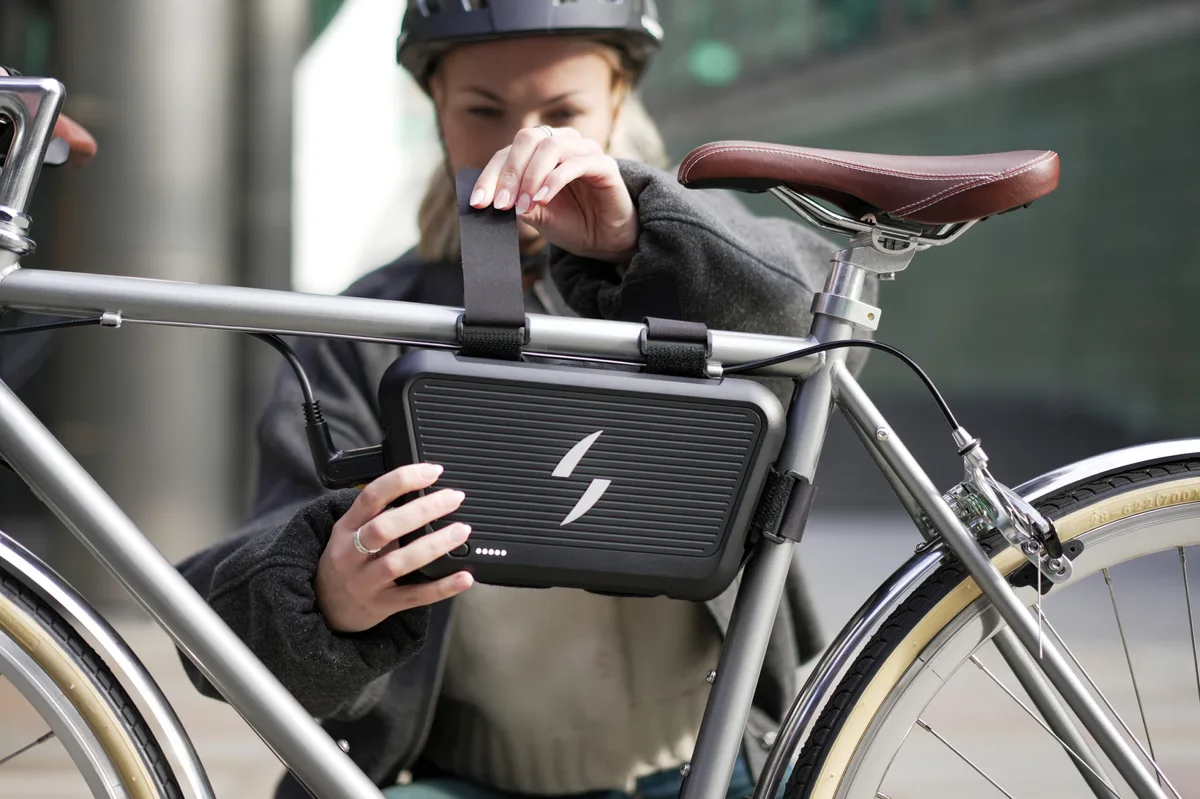
The Swytch Go battery pack can fit into your frame. Swytch The Swytch Go is still an ebike conversion kit, but it’s slightly different from the Max kits.
Instead of a battery that mounts on your handlebar, the Go has a battery pack, which can be mounted in the frame.
Swytch says the Go promises the same ride feel as the Max kits, but that it has a simpler design to bring the cost down.
Revealed in 2023, Swytch said it wanted to create a more affordable kit in response to the cost-of-living crisis.
The Go has 45 per cent off, bringing the price down from £499 to £299.
What about the helmet?
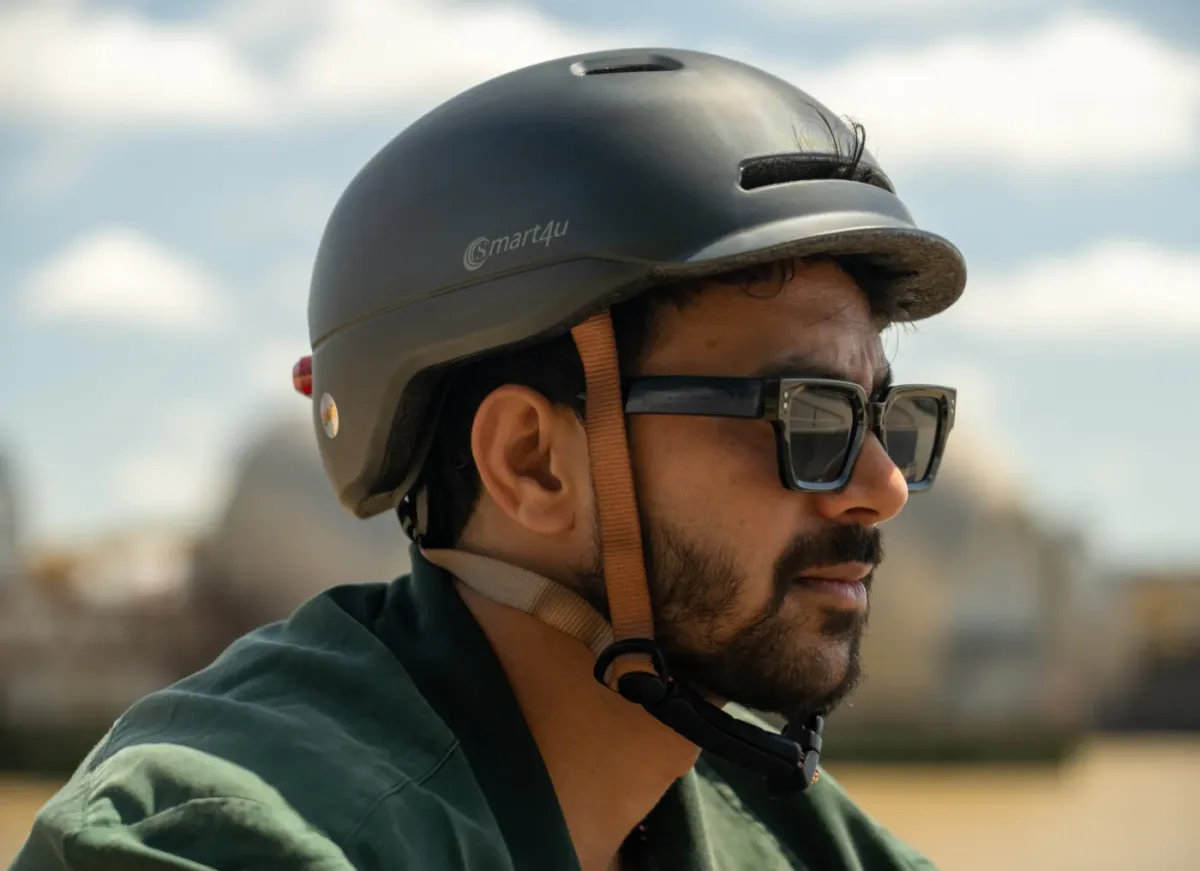
The helmet is worth £70 / $85. Swytch When you sign up to Swytch’s mailing list and order a Max or Go conversion kit this week, you’ll also receive a free smart helmet.
Worth £70 / $85, Swytch says the helmet has auto braking lights, built-in indication and 36-hour battery life.
The helmet has a supporting phone app, handlebar control and universal adjustment.
How do I sign up to Swytch’s mailing list?
To sign up to Swytch’s mailing list, all you need to do is visit Swytch’s website and click ‘Sign Up’.
Continue Reading
-

You Can Now Rent a Flesh Computer Grown in a British Lab : ScienceAlert
The world’s first commercial hybrid of silicon circuitry and human brain cells will soon be available for rent. Marketed for its vast potential in medical research, the biological machine, grown inside a British laboratory, builds on the Pong-playing prototype, DishBrain.
Each CL1 computer is formed of 800,000 neurons grown across a silicon chip, and their life-support system. While it can’t yet match the mind-blowing capabilities of today’s most powerful computers, the system has one very significant advantage: it only consumes a fraction of the energy of comparable technologies.
AI centers now consume countries’ worth of energy, whereas a rack of CL1 machines only uses 1,000 watts and is naturally capable of adapting and learning in real time.
Lab-grown neurons live on an electrode array. (Cortical Labs) “The neuron is self-programming, infinitely flexible, and the result of four billion years of evolution. What digital AI models spend tremendous resources trying to emulate, we begin with,” Australian biotech startup Cortical Labs claims on its website. They teamed up with UK company bit.bio to further develop DishBrain, an experimental platform designed to explore the “wetware” concept.
Related: Human Brain Cells on a Chip Can Recognize Speech And Do Simple Math
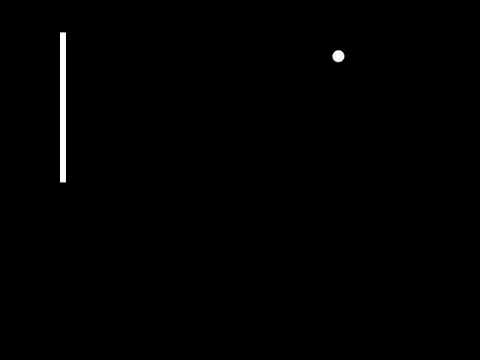 frameborder=”0″ allow=”accelerometer; autoplay; clipboard-write; encrypted-media; gyroscope; picture-in-picture; web-share” referrerpolicy=”strict-origin-when-cross-origin” allowfullscreen>
frameborder=”0″ allow=”accelerometer; autoplay; clipboard-write; encrypted-media; gyroscope; picture-in-picture; web-share” referrerpolicy=”strict-origin-when-cross-origin” allowfullscreen>When neuroscientist Brett Kagan and colleagues pitted their creation against equivalent levels of machine learning algorithms, the cell culture systems outperformed them.
Users can send code directly into the synthetically supported system of neurons, which is capable of responding to electrical signals almost instantly. These signals act as bits of information that can be read and acted on by the cells.
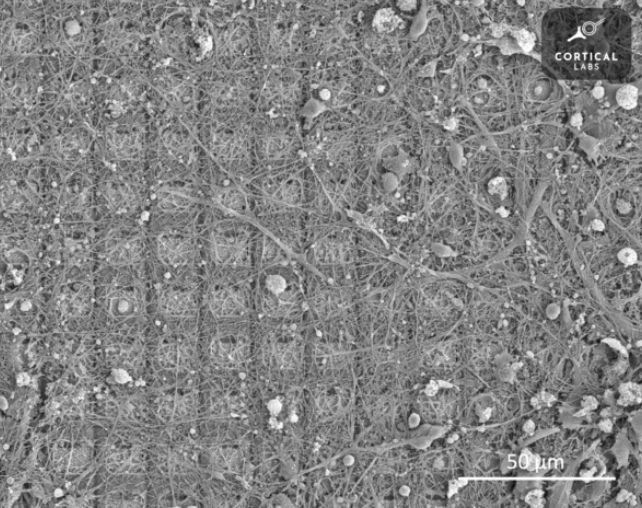
SEM of neural culture grown on a high-density multi-electrode array. The complicated network of cells covering the central electrodes comes from a few neurons growing around the periphery. (Cortical Labs) But perhaps the greatest potential for this biological and synthetic hybrid is as an experimental tool for learning more about our own brains and their abilities, from neuroscience to creativity.
“Epileptic cells can’t learn to play games very well, but if you apply antiepileptics to the cell culture, they can suddenly learn better as well as a range of other previously inaccessible metrics,” Kagan told Shannon Cuthrell at IEEE’s Spectrum, pointing out the system’s ethical drug testing capacity.
The computing neurons are grown from skin and blood samples provided by adult human donors. While there are still many limitations – for one, the neurons only survive for six months at a time – the energy-saving potential of this technology alone suggests such systems are worth developing further. Especially given the dire state of our own life support system.
The first CL1 units will reportedly ship soon for US$35,000 each, or remote access can apparently be rented for $300 per week.
Continue Reading
-

EA’s next Battlefield game may be in trouble and over budget
EA’s next Battlefield game is supposedly arriving sometime in spring 2026, but its development is reportedly fraught with issues, leading some of its developers to worry that certain parts of the game won’t be well-received. According to a lengthy Ars Technica piece about the game’s development troubles and problems facing AAA titles’ development as a whole, EA had lofty goals for the next Battlefield (codenamed Glacier) to the point that team members working on the project think they’re near unrealistic.
The publisher’s executives apparently believed that Glacier could match the popularity of Call of Duty and Fortnite and set a 100 million player target over a certain period of time. An employee told Ars that the franchise has never achieved those numbers before, with Battlefield 2042 getting only up to 22 million players within that same period. The first Battlefield, which was the most successful in the franchise so far, only got to “maybe 30 million plus” within that timeframe.
One of the reasons why Fortnite has over 100 million active users is because it’s free-to-play. In CoD’s case, well, aside from having free-to-play titles, it’s also the biggest gaming franchise and has a lengthy history, so it’s no surprise that it already has a solid fanbase who would play its latest releases. Players had to pay for previous Battlefield games up front, but executives thought that if EA made Glacier free-to-play like its competitors, it could achieve the same numbers. And that is why the publisher promised a free-to-play Battle Royale mode with a six-hour single player campaign for the upcoming game.
Ridgeline, the external studio working on the single player mode, however, shuttered in 2024 after working on the project for two years. The studio reportedly found EA’s objectives unachievable, since it was expected to reach milestones in the same rate as more established studios when it didn’t have the same resources. Now, three other EA studios (Criterion, DICE and Motive) are working on the single-player mode. But since they had to start from scratch, single player is the only Glacier game mode remaining that has yet to reach alpha status.
Due to the wider scope of the next title in the franchise and the issues it has faced, it has become the most expensive Battlefield to date. It had a budget of $400 million back in 2023, but the current projections are now apparently “well north” of that. Whether the next Battlefield launches on time remains to be seen. Ars‘ sources said that if it does ship as intended, they expect some features and content to be cut from the final product.
Continue Reading